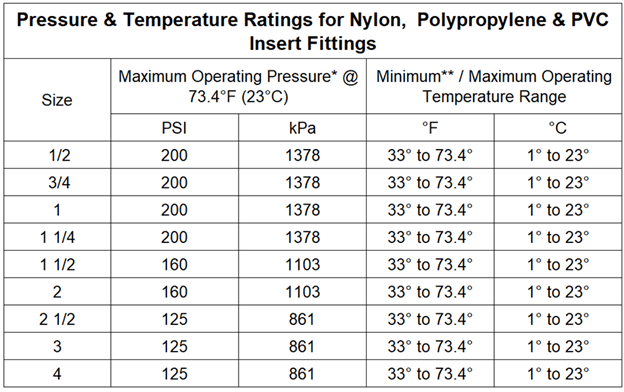Het belang van het begrijpen van de temperatuurwaarden van nylon
Om het juiste materiaal voor een toepassing te kiezen, moet je de eigenschappen en beperkingen van het materiaal goed begrijpen. Als het gaat om nylon, een van de meest gebruikte synthetische polymeren, is een goed begrip van de temperatuurclassificatie van nylon van vitaal belang. Deze kennis zorgt ervoor dat het materiaal optimaal presteert onder de omstandigheden waaraan het wordt blootgesteld, waardoor de algehele betrouwbaarheid en duurzaamheid van het eindproduct worden verbeterd.

De betekenis van de nylon temperatuurclassificatie
Nylon staat bekend om zijn veelzijdigheid en duurzaamheid, maar zijn prestaties worden sterk beïnvloed door de temperatuur. De temperatuurklasse van nylon verwijst naar het bereik waarbinnen het zijn mechanische eigenschappen zoals sterkte, stijfheid en weerstand tegen vervorming kan behouden. Om het juiste nylon materiaal te kiezen, moet je zorgvuldig rekening houden met het temperatuurbereik om te vermijden dat de prestaties in het gedrang komen.
Effecten van het overschrijden van temperatuurgrenzen
Het overschrijden van de aanbevolen temperatuur voor nylon kan thermische degradatie veroorzaken, wat leidt tot een verlies van cruciale eigenschappen zoals sterkte, flexibiliteit en chemische weerstand. Bijvoorbeeld, nylon 6 heeft een temperatuurclassificatie tot 180°C (356°F), terwijl nylon 66 is bestand tegen temperaturen tot 220°C (428°F). Blootstelling aan temperaturen boven deze limieten kan het materiaal aanzienlijk verzwakken.
Invloed van hoge temperaturen op nylon
Hoge temperaturen kunnen nadelige effecten hebben op nylon, zoals broosheid en een verhoogd risico op scheuren. Deze verminderde slagvastheid vermindert de algemene duurzaamheid van het materiaal. Bovendien kunnen hoge temperaturen leiden tot "vergeling", een proces dat de transparantie en kleur van het materiaal verandert, wat de esthetische en functionele kwaliteiten verder aantast.
Gevolgen van lage nylon temperatuurclassificatie
De prestaties van nylon worden niet alleen bedreigd door hoge temperaturen; ook lage temperaturen kunnen schadelijk zijn. Wanneer nylon wordt blootgesteld aan kou, kan het broos worden en vatbaarder voor scheuren, wat ten koste gaat van de slagvastheid en duurzaamheid. Bovendien kunnen lage temperaturen de neiging van het materiaal om vocht te absorberen vergroten, wat resulteert in een verlies van sterkte en stijfheid.
Kritische toepassingen van nylon temperatuurclassificaties
Inzicht in de temperatuurklasse van nylon is vooral van vitaal belang in omgevingen waar het materiaal wordt blootgesteld aan extreme omstandigheden. Industrieën zoals de lucht- en ruimtevaart, de automobielindustrie en industriële omgevingen vertrouwen op deze kennis om de betrouwbaarheid van het materiaal te garanderen. In ruimtevaarttoepassingen worden nylon onderdelen bijvoorbeeld blootgesteld aan hoge temperaturen tijdens de lancering en herintreding.
Relevantie in diverse industrieën van nylon temperatuurclassificatie
Naast de lucht- en ruimtevaart zijn ook de auto-industrie en de industrie sterk afhankelijk van de temperatuurbestendigheid van nylon. In toepassingen voor de auto-industrie wordt nylon vaak gebruikt in riemen, slangen en afdichtingen, die allemaal worden blootgesteld aan hoge temperaturen tijdens het gebruik van de motor. Ervoor zorgen dat het materiaal binnen zijn temperatuurlimieten blijft, is de sleutel tot het behoud van zijn prestaties en betrouwbaarheid.
Conclusie van Nylon Temerature Rating
Inzicht in de temperatuurklasse van nylon is essentieel om het juiste materiaal voor een toepassing te kiezen. Door binnen het aanbevolen temperatuurbereik te blijven, kunnen fabrikanten en ingenieurs ervoor zorgen dat de mechanische eigenschappen van het materiaal behouden blijven, waardoor de prestaties, betrouwbaarheid en duurzaamheid worden gegarandeerd. Deze kennis is vooral belangrijk in industrieën waar materiaaldefecten aanzienlijke gevolgen kunnen hebben.
Nylon Temperatuurclassificatie: Samenvatting FAQ
V: Wat is een nylon temperatuurclassificatie?
A: De nylon temperatuurclassificatie verwijst naar het temperatuurbereik waarbinnen nylon zijn mechanische eigenschappen kan behouden, zoals sterkte, stijfheid en weerstand tegen vervorming.
V: Waarom is het belangrijk om de temperatuurklasse van nylon te begrijpen?
A: Inzicht in de temperatuurclassificatie is cruciaal om het juiste nylon materiaal voor specifieke toepassingen te kiezen, zodat het optimaal presteert en zijn duurzaamheid behoudt onder de gegeven temperatuursomstandigheden.
V: Wat gebeurt er als nylon wordt blootgesteld aan temperaturen boven zijn nominale waarde?
A: Blootstelling van nylon aan temperaturen boven de aanbevolen waarden kan leiden tot thermische degradatie, wat resulteert in een verlies van sterkte, flexibiliteit en chemische weerstand. Het materiaal kan ook broos worden en vatbaar voor barsten.
V: Welk effect hebben hoge temperaturen op nylon?
A: Hoge temperaturen kunnen nylon broos maken, de slagvastheid verminderen en leiden tot "vergeling", waardoor de transparantie en kleur veranderen.
V: Wat zijn de effecten van lage temperaturen op nylon?
A: Lage temperaturen kunnen nylon broos maken en vatbaar voor scheuren, waardoor de duurzaamheid afneemt. Het kan ook de vochtabsorptie verhogen, wat leidt tot een verlies van sterkte en stijfheid.
V: In welke industrieën is inzicht in de temperatuurklasse van nylon bijzonder belangrijk?
A: Inzicht in de temperatuurwaarden van nylon is van vitaal belang in sectoren zoals de ruimtevaart, de automobielindustrie en industriële omgevingen, waar het materiaal vaak wordt blootgesteld aan extreme temperaturen.
V: Welke invloed heeft de temperatuurklasse van nylon op toepassingen in de auto-industrie?
A: In autotoepassingen wordt nylon gebruikt in onderdelen zoals riemen, slangen en afdichtingen die tijdens het gebruik van de motor worden blootgesteld aan hoge temperaturen. Als je de temperatuurclassificatie kent, blijven deze onderdelen goed presteren en betrouwbaar.
